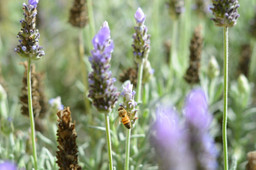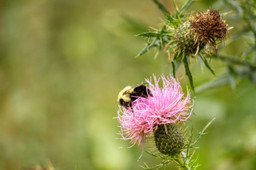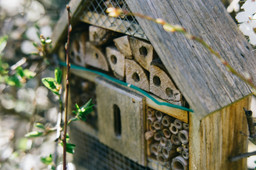
Why bees are important, and how we can help them
What’s so special about bees? You may be surprised to find that there are many more types of bees than the honey- and bumble- varieties which we are most familiar with. Other families include burrowing bees, cuckoo bees, carpenter bees, mason bees, leafcutter bees, resin bees, mining bees, sweat bees, orchid bees, and plasterer bees.
The majority of bee species – more than 90% – are solitary, rather than living in social colonies. Around 550 known species are stingless, and at least one is massive. They are also far more diverse in appearance than we might expect; colorings include blue, green, purple, black, (black-and-) white – and even polka-dotted.
This diversity is in large part due to the equivalent variety of the flowers upon whose nectar and pollen they feed; by co-evolving together, bees underwent a similarly massive diversification, leading to more than 20,000 known species. 🐝
If you require a more self-interested reason to care, “between $235 and $577 billion (U.S.) worth of annual global food production relies on the […] contribution [of honey bees, native bees, and flies]”, while a report on the economic value of bee pollination states that “bee-pollinated crops contribute to approximately one-third of the total human dietary supply”. The report concludes that bee pollination “maintain[s] food security worldwide”.

Why do bees need our help?
There’s no way to sugarcoat it: tragically, what unites all species of bees is that we are exterminating them.
However, despite losses involving incomprehensible numbers, shifting baseline syndrome – whereby we overlook the fact that what we see as normal (eg, the amount of bees in our gardens) is not the same normal as one generation previously – means that we are scarcely aware of the magnitude of what is happening.
These losses are affecting not only bees, but insects in general. To quote at length from a New York Times article by Brooke Jarvis entitled ‘The Insect Apocalypse Is Here’:
“We’ve named and described a million species of insects, a stupefying array of thrips and firebrats and antlions and caddis flies and froghoppers and other enormous families of bugs that most of us can’t even name. […] The ones we think we do know well, we don’t: There are 12,000 types of ants, nearly 20,000 varieties of bees, almost 400,000 species of beetles […]. And yet entomologists estimate that all this amazing, absurd and understudied variety represents perhaps only 20 percent of the actual diversity of insects on our planet — that there are millions and millions of species that are entirely unknown to science.”
Why are bees endangered?
In order of significance, the main causes for the decline of bumblebees, honeybees, and solitary bees (which also apply to other insects which visit flowers: wasps, hoverflies and other flies, moths and butterflies, and some beetles):
- Habitat loss: in Britain alone, 97% of wildflower meadows have been destroyed since the 1930s, as well as declines in suitable nesting and breeding sites
- Intensive farming, which means a decrease in the amount of ‘unproductive’ land vital for wildlife and a reduction of the amount of flowers on farmed land
- Use of pesticides, including weedkillers: these remove food plants and prey for pollinators with herbivorous or predatory larvae. Neonicotinoid insecticides are particularly problematic because they can accumulate in the sap, nectar, and pollen of plants treated with them; exposed insects suffer from seizure, with “behaviourally impaired [bee] individuals affect[ing] the normal function of colonies”
- The spread of diseases and parasites (such as the varroa mite, which originated in East Asia; bees elsewhere, which have no resistance, are being killed by this parasite worldwide)
- Invasive species can also disrupt native species; for example, it is thought that the Asian hornet could decimate British bee species if it becomes established.
Why does the loss of bees matter?
The New York Times article notes the estimated 60% loss of wild land animals’ populations since 1970. The magnitude of this decline is inconceivable – but it is likely not arthropods (exoskeletal invertebrates including insects, arachnids, and crustaceans) which command the greatest sympathy, compared to the more relatably mammalian rhinos, pandas, big cats, and polar bears. Yet where would vertebrate animals (ourselves included) be without arthropods?

Though positioned as a rejoinder to The New York Times’ piece, in ‘The Insect Apocalypse Is Not Here but There Are Reasons for Concern’ (which nevertheless notes “that we might be reaching a point where insect decline becomes irreversible”), The Economist states that:
“Animals, mostly insects, pollinate 87% of flowering plants, according to a recent study […]. Without insects, most plants could not reproduce. They break down and recycle the nutrients that plants need for photosynthesis. They decompose organic waste and feed a large proportion of all birds and bats [and freshwater fish].”
Not to mention maintaining soil health and controlling pests. “As insects become more scarce, our world will slowly grind to a halt, for it cannot function without them.” “Given their diversity and abundance, it is inevitable that insects are intimately involved in all terrestrial and freshwater food chains and food webs”; herbivorous insects convert plant material into insect protein which can be better digested by larger animals. Predators of insect herbivores – for example, wasps and mantises – are themselves preyed upon by a huge variety of vertebrates, such as birds, bats, reptiles, amphibians, fish, and small mammals. Those animals’ predators would eventually also go hungry in a world without insects.
Ultimately, the loss of bees – and insect life more broadly – could lead to catastrophic trophic cascades (ripple effects through ecosystems) which would be deleterious for not just wildlife but humanity too.
What can I do?
Writing in the UK Guardian, biologist Dave Goulson notes that, “Halting and reversing insect declines […] requires action at many levels, from the general public to farmers, food retailers and other businesses, local authorities and policymakers in government.” Here we will focus on what can be done by the general public.
Bees and other insect pollinators (such as moths and hover flies) need three things:
- Food: year-round sources of nectar and pollen: flowering plants that can be grown in pots, gardens, and public spaces, etc
- Shelter: for solitary bees in particular, this could include ‘bee hotels’ – but a pile of (untreated) wood, like branches or even pruned twigs, would also be beneficial. And/or, leave some (or all) of your lawn untrimmed – or at least not mown so short – to give both shelter and additional flowers to feed from
- Water: necessary for producing food for young, and to maintain a cool humidity in hives, provide a tray, bucket, or birdbath filled with (ideally) rainwater, with some stones or other objects added for bees to land on.

Also beneficial would be swearing off of the toxic pesticides and herbicides which are contributing to bees’ decline. Consider adding your name to anti–neonicotinoid petitions (the UK currently has the least stringent neonicotinoid regulations in Europe, the government having overturned scientific advice) and joining campaigns against its use.
And do check out our follow-up article about which pollinator-friendly plants you could consider growing! 🌼
Earth.fm soundscapes you may enjoy:
- Bee Sounds – Inside a Beehive
- Bluethroat and Bumblebees
- Spring in the Himalayan Foothills
- Meadow Atmosphere
Featured photo by Boris Smokrovic on Unsplash
Earth.fm is a completely free streaming service of 1000+ nature sounds from around the world, offering natural soundscapes and guided meditations for people who wish to listen to nature, relax, and become more connected. Launched in 2022, Earth.fm is a non-profit and a 1% for the Planet Environmental Partner.
Check out our recordings of nature ambience from sound recordists and artists spanning the globe, our thematic playlists of immersive soundscapes and our Wind Is the Original Radio podcast.
You can join the Earth.fm family by signing up for our newsletter of weekly inspiration for your precious ears, or become a member to enjoy the extra Earth.fm features and goodies and support us on our mission.
Subscription fees contribute to growing our library of authentic nature sounds, research into topics like noise pollution and the connection between nature and mental wellbeing, as well as funding grants that support emerging nature sound recordists from underprivileged communities.

